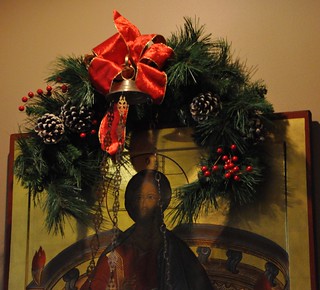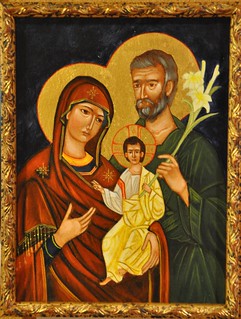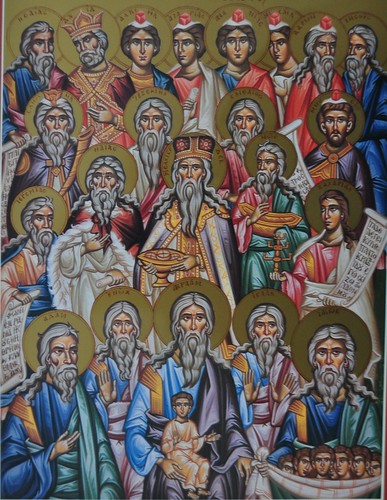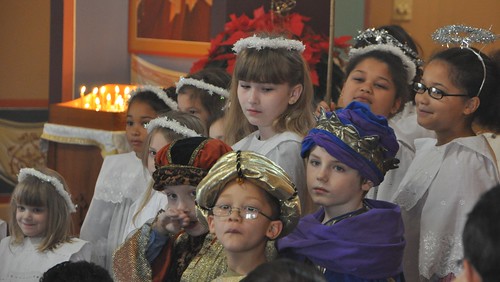 Orthodox liturgical practice has undergone significant development over its 2000 year history. There were times in Orthodox history in which differing practices could be found occurring simultaneously in various parts of the Byzantine Empire. Over time some of these practices disappeared, some were changed, and some came to predominate over other variations. Christmas is one season that has undergone change through the centuries. The Nativity Fast itself underwent change and development. As noted in a previous blog at one time monasteries kept Christmas Eve as a feast day not a strict fast day. By the time of St. Gregory of Palamas (14th Century), in the Orthodox liturgical practice,
Orthodox liturgical practice has undergone significant development over its 2000 year history. There were times in Orthodox history in which differing practices could be found occurring simultaneously in various parts of the Byzantine Empire. Over time some of these practices disappeared, some were changed, and some came to predominate over other variations. Christmas is one season that has undergone change through the centuries. The Nativity Fast itself underwent change and development. As noted in a previous blog at one time monasteries kept Christmas Eve as a feast day not a strict fast day. By the time of St. Gregory of Palamas (14th Century), in the Orthodox liturgical practice,
“… the entire month of December had taken on the character of a forefeast for Christmas. In this context, the theme of the original preparatory Sunday, the ‘Sunday of the Holy Fathers’ […], commemorating the ancestors of Christ ‘according to the flesh’ […], especially the patriarch Abraham, to whom the promise was first given (Gen. 12:3, 22:18), is fundamental to the whole period. Later, however, two additional preparatory Sundays were established, which broadened the original theme to include all the righteous of the Old Dispensation – all those who were well-pleasing to God from Adam to Joseph the Betrothed, including those men and women who had prophesied of the coming of Christ, especially the prophet Daniel and the Three Holy Children (whose feastday falls on 17 December). Hence, the first Sunday before Christmas (between 18 to 24 December) became known as the ‘Sunday before the Nativity of Christ’ […], while the second Sunday (between 11 to 17 December) took on the name, ‘Sunday of the Holy Forefathers of Christ’ […] – to distinguish them from the Fathers of the ecumenical councils, while the third Sunday before Christmas (between 1 to 10 December) is simply an extension of the second, continuing the remembrance of all those who lived before and under the law, and is marked by the readings of Luke 13:10-17, which speaks of the Crippled Woman who was Healed by Christ on the Sabbath as a ‘daughter of Abraham’. ” (endnotes, St. Gregory Palamas Homilies, p 632)

So St. Matthew begins his Gospel and genealogy with the Patriarch Abraham.
MATTHEW 1:1-25
The book of the genealogy of Jesus Christ, the son of David, the son of Abraham. Abraham was the father of Isaac, and Isaac the father of Jacob, and Jacob the father of Judah and his brothers, and Judah the father of Perez and Zerah by Tamar, and Perez the father of Hezron, and Hezron the father of Ram, and Ram the father of Amminadab, and Amminadab the father of Nahshon, and Nahshon the father of Salmon, and Salmon the father of Boaz by Rahab, and Boaz the father of Obed by Ruth, and Obed the father of Jesse, and Jesse the father of David the king. And David was the father of Solomon by the wife of Uriah, and Solomon the father of Rehoboam, and Rehoboam the father of Abijah, and Abijah the father of Asa, and Asa the father of Jehoshaphat, and Jehoshaphat the father of Joram, and Joram the father of Uzziah, and Uzziah the father of Jotham, and Jotham the father of Ahaz, and Ahaz the father of Hezekiah, and Hezekiah the father of Manasseh, and Manasseh the father of Amos, and Amos the father of Josiah, and Josiah the father of Jechoniah and his brothers, at the time of the deportation to Babylon. And after the deportation to Babylon: Jechoniah was the father of Shealtiel, and Shealtiel the father of Zerubbabel, and Zerubbabel the father of Abiud, and Abiud the father of Eliakim, and Eliakim the father of Azor, and Azor the father of Zadok, and Zadok the father of Achim, and Achim the father of Eliud, and Eliud the father of Eleazar, and Eleazar the father of Matthan, and Matthan the father of Jacob, and Jacob the father of Joseph the husband of Mary, of whom Jesus was born, who is called Christ. So all the generations from Abraham to David were fourteen generations, and from David to the deportation to Babylon fourteen generations, and from the deportation to Babylon to the Christ fourteen generations.

Now the birth of Jesus Christ took place in this way. When his mother Mary had been betrothed to Joseph, before they came together she was found to be with child of the Holy Spirit; and her husband Joseph, being a just man and unwilling to put her to shame, resolved to divorce her quietly. But as he considered this, behold, an angel of the Lord appeared to him in a dream, saying, “Joseph, son of David, do not fear to take Mary your wife, for that which is conceived in her is of the Holy Spirit; she will bear a son, and you shall call his name Jesus, for he will save his people from their sins.” All this took place to fulfill what the Lord had spoken by the prophet: “Behold, a virgin shall conceive and bear a son, and his name shall be called Emmanuel” (which means, God with us). When Joseph woke from sleep, he did as the angel of the Lord commanded him; he took his wife, but knew her not until she had borne a son; and he called his name Jesus.
St. Maximus the Confessor (7th Century) writes:
“Therefore the mystery of the Incarnation of the Word contains in itself the whole meaning of the riddles and symbols of Scripture, the whole significance of visible and invisible creatures. Whoever knows the mystery of the cross and the tomb knows the meanings of things. Whoever is initiated into the hidden meaning of the resurrection knows the purpose for which God created everything in the beginning.

The Incarnation was therefore the product of a long history, a fleshly fruit that had long been ripening on the earth. This was the point of view of Irenaeus of Lyons who in the second century worked out a real theology of history expressed as a grand succession of covenants (with Adam, Noah, Abraham, Moses, and so on). Whilst humanity thus tested its freedom, an ever-diminishing ‘remnant’ meditated on and refined its expectations until a woman, Mary, by giving her indispensable assent, as last made possible the perfect union of the divine and the human. The history continues today; Life continues to be offered, not imposed. Today also, amidst the titanic undertakings of the modern age, people have desired ‘to see even before becoming adult the disappearance of every difference between God and humanity’. The movement from the God-man to God-humanity is now possible only because of the patience of the saints, who have slowly established their communion.” (Olivier Clément, The Roots of Christian Mysticism, p 40)


